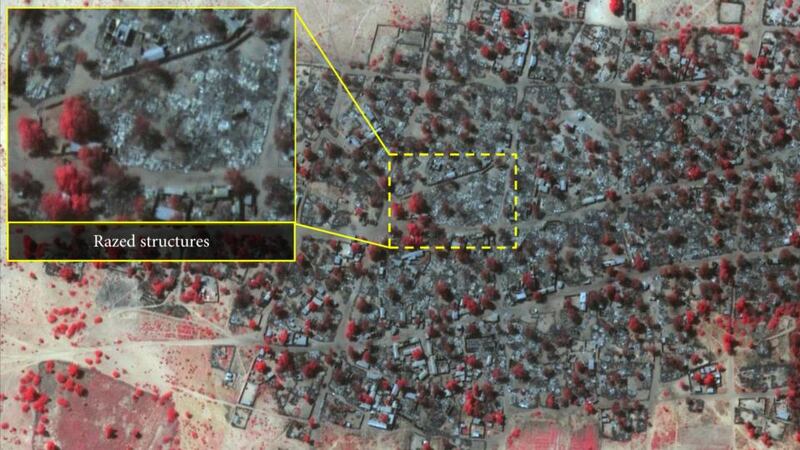Amnesty International has released satellite images it says shows the scale of a recent Boko Haram attack which may have left as many as 2,000 people dead in the north-eastern corner of Nigeria.
The images provide “indisputable and shocking evidence” of the attack, the rights organisation said.
The images, taken on the 2nd and 7th of January show the devastating effect of the attacks on two villages near the border with Chad which Amnesty says left over 3,700 structures damaged or completely destroyed.

"These detailed images show devastation of catastrophic proportions in two towns, one of which was almost wiped off the map in the space of four days," said Daniel Eyre, Nigeria researcher for Amnesty International.
“Of all Boko Haram assaults analysed by Amnesty International, this is the largest and most destructive yet. It represents a deliberate attack on civilians whose homes, clinics and schools are now burnt out ruins,” he said.
Survivors have described days of relentless violence in which, according to one witness, some people were slaughtered “like insects”.
Calling for an investigation into alleged war crimes and crimes against humanity, Amnesty said the Nigerian government should take all possible legal steps to restore security in the north-east and ensure protections of civilians.
Amnesty said interviews with eyewitnesses, local government officials, and local human rights activists suggest that Boko Haram militants shot hundreds of civilians.
“This week, Nigeria’s Director of Defence Information stated that the number of people killed in Baga including Boko Haram fighters “has so far not exceeded about 150. These images, together with the stories of those who survived the attack, suggest that the final death toll could be much higher than this figure,” Mr Eyre said.
A man in his fifties described what happened in Baga during the attack: “They killed so many people. I saw maybe around 100 killed at that time in Baga. I ran to the bush. As we were running, they were shooting and killing.”
He hid in the bush and was later discovered by Boko Haram fighters, who held him in Doron Baga for four days.
Others who escaped described seeing many more corpses in the bush. “I don’t know how many but there were bodies everywhere we looked,” one woman told Amnesty.
Another witness described how Boko Haram militants shot indiscriminately killing small children and killed a woman who was in labour.
“Half of the baby boy is out and she died like this,” he said.
Amnesty’s analysis focuses on just two towns and villages that fell victim to a series of Boko Haram attacks which began on January 3rd after militants seized a key military base in the area.
In the small town of Baga approximately 620 structures were damaged or completely destroyed by fire while in Doron Baga over 3,100 structures were damaged or destroyed by fire.
The images taken on the 2nd of January show wooden fishing boats along the shoreline but they are no longer present in the images taken on January 7th. This tallies with reports that residents fled by boat across Lake Chad.
Boko Haram fighters have repeatedly targeted communities they suspect of collaboration with the security forces.
Towns and villages that have formed state-sponsored militia groups known as the Civilian Joint Task Force (Civilian JTF) have suffered particularly brutal attacks, Amnesty says.
After the attack on Baga, witnesses describe how Boko Haram drove into the bush rounding up women, children and the elderly who had escaped.
According to one woman interviewed after she was detained by Boko Haram for four days, “Boko Haram took around 300 women and kept us in a school in Baga. They released the older women, mothers and most of the children after four days but are still keeping the younger women.”










